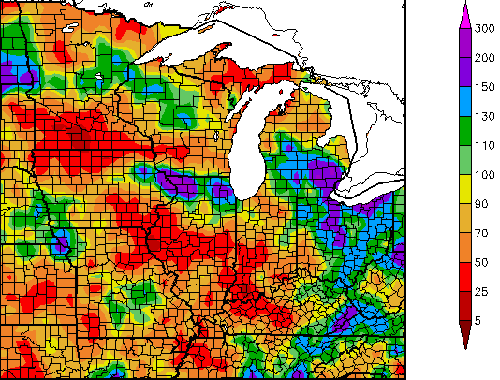Fall predictions for landscape trees
Weather patterns may impact fall color and winter injury to landscape trees.
Fall chill is in the air, so that can only mean one thing: time for predictions. Will the Lions make the playoffs? How far will the Tigers go? Will we have good fall color? Will we see a lot of winter injury on landscape trees?
The first two are easy. Yes, if the O-line keeps Mathew Stafford upright and all the way to the World Series where they’ll lose to the Phillies in six games. The other two questions are much more complex and the answer will likely vary depending on which part of the state you’re in.
Rainfall patterns the past couple months have divided Michigan into “haves” and “have nots.” For people living in southern Lower Peninsula, rainfall has been average or above average since the middle of July, with southeast Michigan receiving well above average rainfall. The situation changes dramatically, however, as we work our way northward. Starting at about Mt. Pleasant, most of the northern Lower Peninsula has only received 50 to 75 percent of normal rainfall since mid-July. In some northern locations and in the Upper Peninsula, the drought situation is even worse.
Percent of normal precipitation (%)
7/18/2011 - 9/15/2011

Generated 9/16/2011 at HPRCC using provisional data. Regional Climate Centers
So, how does this affect trees going in to fall and winter? As many people are aware, the best fall color scenario is set up by clear days and cool – but not freezing – nights. Fall color in Michigan is largely due to maples and oaks, along with a few other trees such as sassafras. As these trees begin to lose their leaves, fall color is produced by a couple of biochemical changes.
First chlorophyll, the green pigment in leaves, begins to breakdown. This reveals yellow and yellow-orange pigments (carotenoids) that were previously hidden by the green chlorophyll. In addition, sunny conditions favor production of other pigments (anthocyanins) that contribute to deeper reds and purple. If trees are under stress, as they currently are in northern Michigan, this can impact fall color by limiting anthocyanin production (more yellows, less deeper colors) and by shortening the length of the display since trees may drop leaves quickly due to stress. So potentially we are looking at good fall color for southern Lower Michigan and a shorter, perhaps more muted, fall display for northern Michigan and the Upper Peninsula.
Current weather patterns may also impact cold hardiness of deciduous trees and shrubs as well as conifers. As with fall color, the best case scenario for trees entering winter is a fall with adequate moisture and gradually cooler temperatures. As days get shorter and nights get colder, cold hardiness increases as plants increase the concentration of sugars and other compounds that act as anti-freeze during the winter. Accumulation of these compounds allows trees and shrubs in Michigan to survive temperature well below 0°F. If trees are stressed during the fall, however, they may be less able to synthesize the compounds needed to withstand severe cold during the middle of winter and we can see increased injury. This can be manifest in several ways, but most often appears as branch and crown dieback when trees break bud the following spring. Mid-winter injury is most common on species grown north of their native range such as redbud, sweetgum and baldcypress, but can occur even in native species during severe winters.
Homeowners and landscapers in drought-affected northern Michigan should irrigate trees to help insure they are ready for the upcoming winter. In the absence of rainfall, one good, long soak per week until leaf-fall should be adequate to reduce adverse drought affects. Cycling between dry and wet conditions is better for acclimation processes in trees than constant irrigation or soils continually wet.
Dr. Cregg's work is funded in part by MSU's AgBioResearch.



 Print
Print Email
Email



